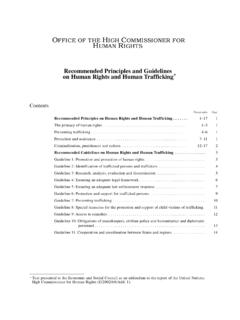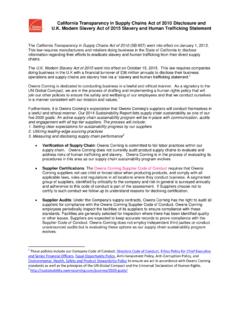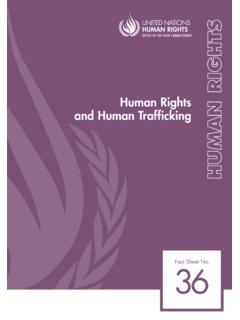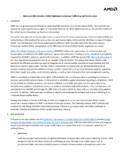Transcription of Human Trafficking: The Role of the Health Care …
1 Human trafficking : The Role of the Health care provider May 14, 2014. Welcome to the webinar! We will begin in a moment. To listen to audio via phone: Call: 855-747-8824. Passcode: 826819. For technical support, call Adobe: 800-422-3623. The slides and recording from today's webinar will be available to download after the event: This webinar is sponsored by the National Health Collaborative on Violence and Abuse. Learning Objectives 1. Understand the background and statistics of Human trafficking . 2. Describe ways in which Health care providers can identify and assist victims and survivors. 3. Identify screening tools and understand reporting requirements. 4. Understand how programs and services can be designed to be more supportive and avoid re-traumatization. Speakers Moderator: Frances Ashe-Goins, MPH, RN, ADN, BSN, Associate Holly Smith, Survivor of Human trafficking .
2 Director for Partnerships and Programs, Department of Health Author of Walking Prey and Human Services, Office on Women's Health Wendy Macias Konstantopoulos, MD, MPH, Medical Natalie McClain, PhD, RN, CPNP, Clinical Associate Director, Human trafficking Initiative; Department of Professor, William F. Connell School of Nursing, Emergency Medicine, Massachusetts General Hospital Boston College Human trafficking and Health care Wendy Mac as Konstantopoulos, , Division of Global Health & Human Rights Department of Emergency Medicine Massachusetts General Hospital Harvard Medical School Boston, MA. MGH Human trafficking Initiative 2014 Massachusetts General Hospital Presenter Disclosures The following personal financial relationships with commercial interests relevant to this presentation existed during the past 12 months: No disclosures to report 2014 Massachusetts General Hospital Outline Definition International law and Human trafficking globally federal law and Human trafficking in the Risk factors Mechanisms of recruitment Power and control tactics Health needs Public Health implications Health care entry points Role of Health care professional 2014 Massachusetts General Hospital What is Human trafficking ?
3 Form of modern-day slavery Profit from the exploitation of others Compelled service 2014 Massachusetts General Hospital International Law Act Means* Purpose Prostitution Threat Recruiting Pornography Force/Coercion Transporting Forced labor Abduction Transferring Involuntary Fraud servitude Harboring Deception Debt bondage Receiving Abuse of power Slavery or slave-like practices *Exception: minors < 18yrs UN Protocol to Prevent, Suppress and Punish trafficking in Persons Especially Women and Children, 2000. 2014 Massachusetts General Hospital Human trafficking Globally million persons worldwide are trapped in forced labor (roughly 3 out of every 1,000 persons). (ILO, 2012). One of the most profitable criminal industries (US Dept of State, 2010). 32 billion USD per year (ILO, 2005). 2014 Massachusetts General Hospital Forms of Human trafficking Forced labor Sex trafficking Debt bondage Involuntary domestic servitude Forced child labor Child soldiers Child sex trafficking Organ trafficking Department of State, 2011.
4 2014 Massachusetts General Hospital Federal Law Defines severe forms of Human trafficking as: (A) sextrafficking in which a commercial sex act is induced by force, fraud, or coercion, or in which the person induced to perform such act has not attained 18 years of age; or (B) therecruitment, harboring, transportation, provision, or obtaining of a person for labor or services, through the use of force, fraud, or coercion for the purpose of subjection to involuntary servitude, peonage, debt bondage, or slavery. trafficking Victims Protection Act of 2000 ( 106-386). 2014 Massachusetts General Hospital Human trafficking in the Involves men, women, and children citizens and foreign-born nationals Main countries of origin (2012): Mexico, Thailand, the Philippines, Honduras, Indonesia, and Guatemala (US Dept of State, TIPS 2013).
5 Occurs in many licit and illicit industries brothels, massage parlors, street prostitution, hospitality services, agriculture, manufacturing, cleaning services, construction, child and elder care , and housekeeping services (US Dept of State, TIPS 2013). 2014 Massachusetts General Hospital Human trafficking in the HT Reporting System data between 2008-2010: 83% of confirmed sex trafficking victims were US. citizens 95% of confirmed labor trafficking victims were foreign-born nationals (67% undocumented and 28% legal immigrants). (Banks and Kyckelhahn, US DoJ, 2011). 2014 Massachusetts General Hospital Risk Factors Who is at greatest risk? History of child sexual abuse Family dysfunction Substance use Poverty Lack of education and/or employment opportunities Gender inequalities Cognitive and learning disabilities Runaway or throwaway episodes Homelessness 2014 Massachusetts General Hospital Mechanisms of Recruitment Abduction / violence FORCE.
6 False employment opportunities False once-in-a-lifetime FRAUD. opportunities Peer recruitment by operative . COERCION. Psychological manipulation 2014 Massachusetts General Hospital Power & Control Tactics Psychological manipulation Physical abuse Sexual abuse Economic abuse Abuse of power Isolation Source: Polaris Project 2014 Massachusetts General Hospital Health Needs Physical injuries Sexually-transmitted infections and related diseases High-risk and/or unwanted pregnancies Malnutrition Infectious diseases and non-infectious diseases Somaticized symptoms Dental disease and/or injury Substance abuse Mental Health 2014 Massachusetts General Hospital Public Health Implications Silverman et al., 2007. 38% HIV prevalence among repatriated sex-trafficked Nepalese girls and women in Kathmandu. Among girls trafficked prior to age 15, infection rates exceeded 60%.
7 2014 Massachusetts General Hospital Health care Entry Points Emergency departments Community Health clinics Primary care practices Reproductive Health / family planning clinics Cosmetic practices 2014 Massachusetts General Hospital Relevance to Health Human trafficking is a social ill that detracts from the Health and well-being of individuals and communities Health care professionals are in a position to identify, assist, and/or care for victims and survivors 50% survivors reported having received medical care while trafficked (Baldwin et al, 2011). Windows of opportunity 2014 Massachusetts General Hospital Role of Health care Professional Prevention Education and training Patient care Victim identification Referral to services Research Advocacy Policy 2014 Massachusetts General Hospital Confronting Commercial Sexual Exploitation and Sex trafficking of Minors in the United States Natalie McClain, PhD, RN, CPNP.
8 Clinical Associate Professor William F. Connell School of Nursing Boston College Report Release September 25, 2013. Committee on the Commercial Sexual Exploitation and Sex trafficking of Minors in the United States Ellen Wright Clayton, (Co-Chair), Sharon F. Lambert, George Vanderbilt University Washington University Richard D. Krugman, (Co-Chair), Mark Latonero, University of Southern University of Colorado School of California Medicine Natalie McClain, Connell School of Tonya Chaffee, University of Nursing, Boston College California San Francisco Callie Marie Rennison, University of Angela Diaz, Mount Sinai School of Colorado Denver Medicine John A. Rich, Drexel University Abigail English, Center for School of Public Health Adolescent Health and the Law Jonathan Todres, Georgia State Barbara Guthrie, Yale University University College of Law School of Nursing Patti Toth, Washington State Criminal Justice Training Commission 9.
9 Statement of Task: What We Were Asked to Examine Scope and severity Causes and consequences Experiences among populations served by child welfare and juvenile justice systems Evidence associated with prevention and intervention efforts Lessons learned through advocacy efforts Adequacy of current state and federal laws 7. Statement of Task: What We Were Asked to Recommend Policies and practices for Human services, Health care agencies, juvenile justice agencies, law enforcement, and the judiciary New legislative approaches Research agenda 8. 1. Organization of the Report Part I Understanding Commercial Sexual Exploitation and Sex trafficking of Minors in the United States Nature and extent Risk factors and consequences Laws Part II Current and Emerging Strategies Legal system Health and Health care Victim and support services Education sector Commercial sector Part III Overall conclusions and recommendations 11.
10 Guiding Principles Commercial sexual exploitation and sex trafficking of minors should be understood as acts of abuse and violence. Minors should not be considered criminals. Identification and any intervention should do no further harm. 12. Organization of the Report Part I Understanding Commercial Sexual Exploitation and Sex trafficking of Minors in the United States Nature and extent Risk factors and consequences Laws 11. Part I: Consequences Physical Health Mental Health Developmental and Social Societal Consequences Danger of Continued Involvement in Commercial Sex Work Risk of Reexploitation Legal Consequences 11. Part I: Current Laws State Safe Harbor Statutes (Table 4-1). No fixed definition of a safe harbor law Guidelines for drafting legislation Connecticut, Florida, Illinois, Massachusetts, Minnesota, New York, Vermont, and Washington (Texas through judicial decision not statue).






